Real Estate: Pushing to bring back L.I. flora
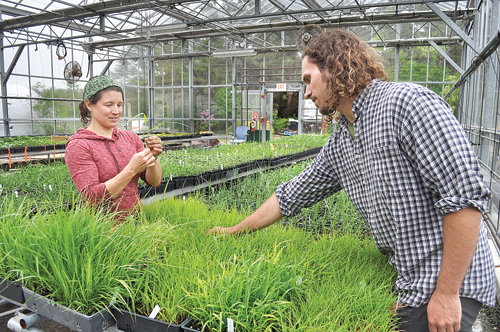
Centuries ago, before the onset of industrialization, wild plants and grasses grew freely across all Long Island, decorating the landscape and providing sustenance for local wildlife. Things are drastically different now, of course.
Much of the region’s original landscape has been replaced by housing developments and shopping centers and, in those areas, plants from across the globe have been planted and take shape each spring. Meanwhile, native plants and grasses have become harder to find.
The Long Island Native Plant Initiative, however, is working to make the hunt for indigenous plants a bit easier.
“We go out and collect the seeds from wild populations of native plants that are common on Long Island to provide the plant material for the industry to grow,” says Polly Weigand, executive director of the Hampton Bays-based organization, which was founded in 2005 and advocates for the propagation of native plant genotypes.
Ms. Weigand, who is also a soil technician for the Suffolk County Soil and Water Conservation District, says planting native species is crucial to protecting local biodiversity.
“Wildlife need these plants in order to survive,” she says. “If everyone was able to implement native plants into their landscapes, that would provide habitats for the small animals that depend on them. From an environmental perspective, it’s also important to plant [native plants] because they don’t require fertilizer or supplemental irrigation.”
Below, Ms. Weigand shares her picks for the three best-selling native plants and grasses, along with two more unusual varieties.
BEST SELLERS
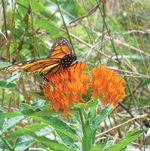 Butterfly weed: “It’s not a weed, despite the name,” Ms. Weigand says. “It’s a milkweed that likes dry areas. The butterfly weed has bright orange flowers and people are attracted to it because of its form and its flowers. Its vegetation is the host plant for monarch butterflies when they’re in the caterpillar phase.”
Butterfly weed: “It’s not a weed, despite the name,” Ms. Weigand says. “It’s a milkweed that likes dry areas. The butterfly weed has bright orange flowers and people are attracted to it because of its form and its flowers. Its vegetation is the host plant for monarch butterflies when they’re in the caterpillar phase.”
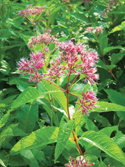 Joe-pye weed: Also not a weed. “People like this one because it attracts butterflies and pollinators,” Ms. Weigand says. “It has a striking pink flower and it also provides a very good habitat for wildlife and birds. The joe-pye weed tolerates a wide range of soil types and it gets up to six feet tall. It’s showy and dramatic.”
Joe-pye weed: Also not a weed. “People like this one because it attracts butterflies and pollinators,” Ms. Weigand says. “It has a striking pink flower and it also provides a very good habitat for wildlife and birds. The joe-pye weed tolerates a wide range of soil types and it gets up to six feet tall. It’s showy and dramatic.”
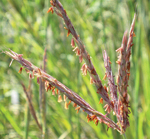 Big blue stem: “It’s a tall bunch grass and it has a beautiful flower that looks like an upside down turkey foot,” Ms. Weigand says. “Big blue stems have green foliage that has a beautiful purplish-blue tint to it. The bunched grass itself will get three to four feet high and then the flowers will come out the top.”
Big blue stem: “It’s a tall bunch grass and it has a beautiful flower that looks like an upside down turkey foot,” Ms. Weigand says. “Big blue stems have green foliage that has a beautiful purplish-blue tint to it. The bunched grass itself will get three to four feet high and then the flowers will come out the top.”
UNUSUAL VARIETIES
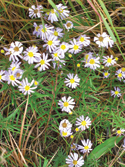 Stiff aster: “It has very rigid foliage and narrow green leaves,” Ms. Weigand says. “The stiff aster has a beautiful purple flower with light yellow in the center. It’s shorter than the New England aster and has a different form. The stiff aster is native to the East End and likes dry places.”
Stiff aster: “It has very rigid foliage and narrow green leaves,” Ms. Weigand says. “The stiff aster has a beautiful purple flower with light yellow in the center. It’s shorter than the New England aster and has a different form. The stiff aster is native to the East End and likes dry places.”
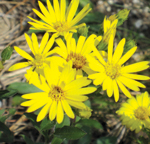 Maryland golden aster: “Don’t be fooled by the name,” Ms. Weigand says. “This flowering plant is local and has fuzzy leaves shaped like rosettes. It produces beautiful, striking yellow flowers. It provides wildlife benefits, and it’s one people have probably never seen in the nursery industry. When you see it blooming, it’s a show-stopper.”
Maryland golden aster: “Don’t be fooled by the name,” Ms. Weigand says. “This flowering plant is local and has fuzzy leaves shaped like rosettes. It produces beautiful, striking yellow flowers. It provides wildlife benefits, and it’s one people have probably never seen in the nursery industry. When you see it blooming, it’s a show-stopper.”






